This article is based on a presentation given by Melissa at our virtual Customer Success Festival in March 2023 when she occupied the position of VP of Customer Success at Screencastify.
Catch up on this presentation, and others, using our OnDemand service. For more exclusive content, visit your membership dashboard.
Steering the ship of customer success in today's dynamic SaaS landscape requires more than just a compass; it demands a deep dive into the ocean of customer sentiment. It's not enough to simply collect feedback; the true art lies in interpreting and weaving that feedback into the very fabric of the customer journey.
I’m Melissa McMillan, VP of Customer Success at Screencastify. Over the last decade, I've dedicated myself to building customer success teams. My journey has taken me through the exciting challenge of establishing CS departments from the ground up - transforming them into efficient, effective units that are integral to a company's fabric.
My role has always been to lay the groundwork - implementing software, creating processes and customer journeys, and assembling a team that can deliver on our promise of success to every customer.
In this article, I'll guide you through the intricate process of using sentiment to refine customer journeys, ensuring that your service isn't just a tool they use, but a cornerstone of their success.
The 5 stages of customer success maturity
In the realm of customer success, especially within the SaaS world, there's a common understanding that the maturation of a CS function can be segmented into five key stages of development.
This isn't a concept I came up with, but it's one I firmly believe in and have seen play out time and time again. Let's walk through these stages to help pinpoint where your CS organization might stand.
Stage 1
At this initial stage, a company might not have a customer success department at all, or if it does, it's in its infancy and not truly practicing the principles of customer success.
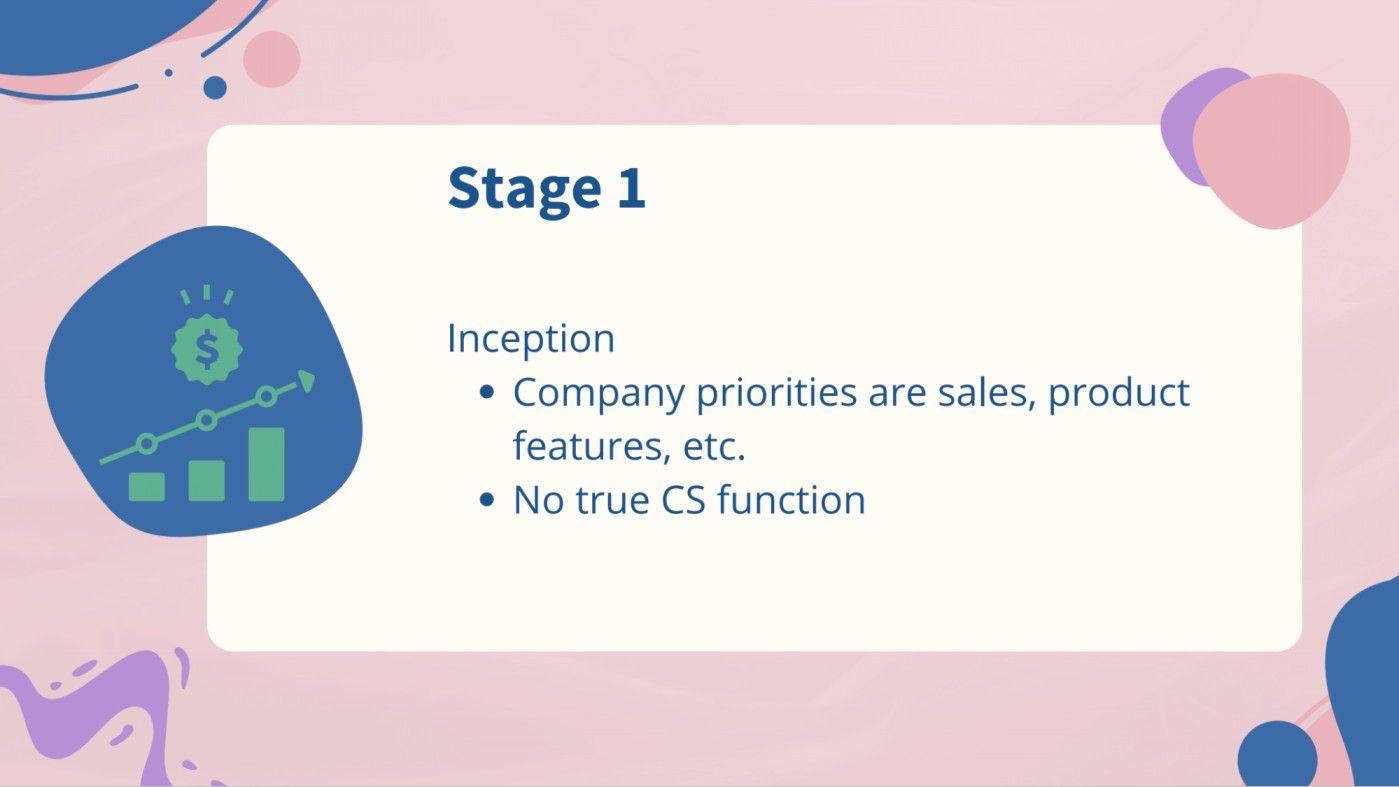
The focus at this level is predominantly on sales, the allure of new product features, and perhaps the basics of customer onboarding and renewals - if there are any Customer Success Managers (CSMs) in place.
Stage 2
Moving on to the second stage, there's an evolution, albeit a modest one. Here, the company hasn't yet embraced customer success best practices, such as strategically aiding customers in achieving their goals.
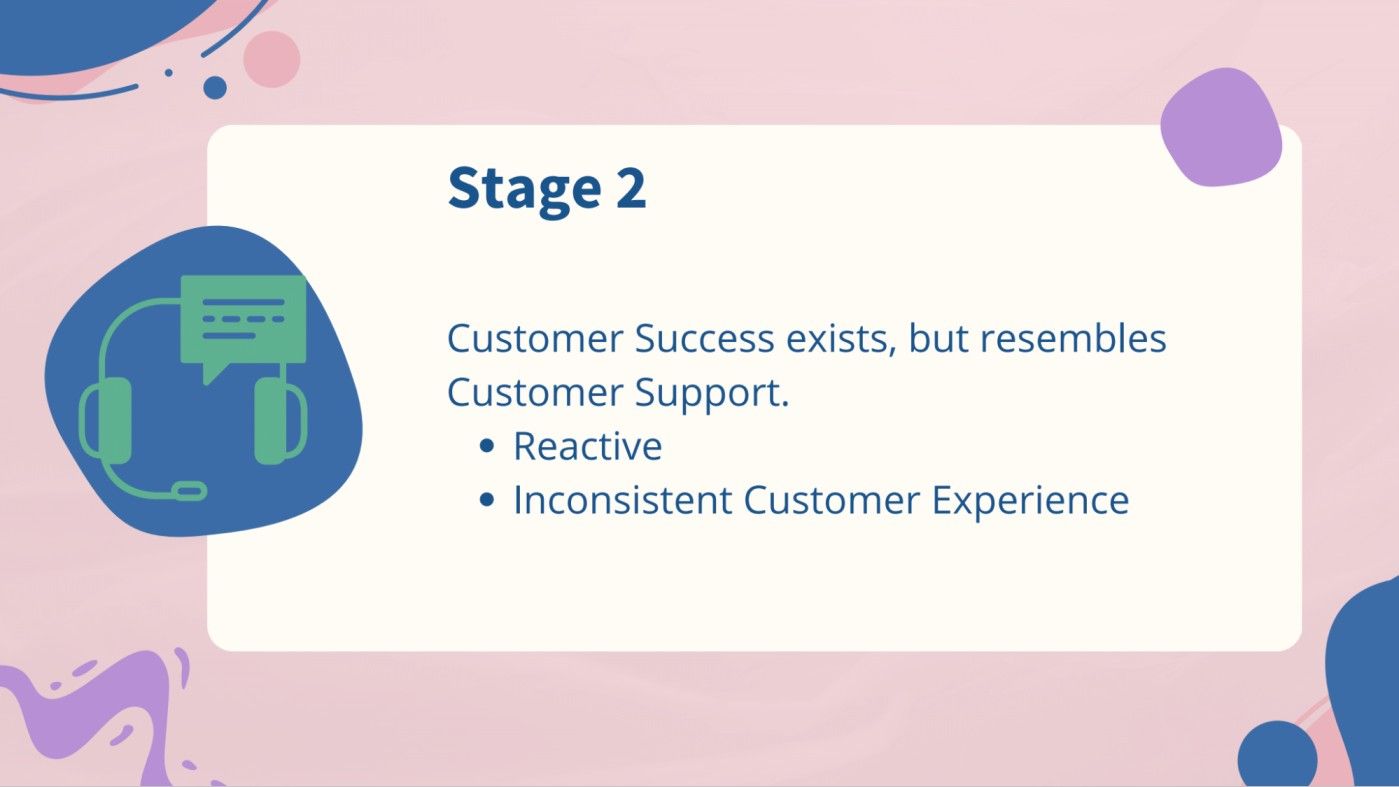
CSMs may act more as advanced support or renewal managers. Sentiment tracking and forecasting might be rudimentary, often managed through spreadsheets and weekly meetings, without the aid of specialized tools.
Stage 3
By stage three, we're gaining momentum. We've implemented a customer success tool - think Gainsight, ChurnZero, or Vitally.
With such tools, we begin to automate customer journeys and effectively track health scores, sentiment, and usage metrics. I'll delve deeper into how to get these CS tools approved by your CFO and CEO later on, along with the setup for tracking.
Stage 4
This stage is where the customer experience becomes mature and seamless. The transition from stage three to four is marked by extracting value and impact from the CS software in use.

We apply the insights we've gathered - for instance, if we notice that users engaged with a particular feature have higher adoption and renewal rates, we tailor our onboarding to emphasize that feature.
At this level, we have a sophisticated system for tracking sentiment through multiple channels, including usage data, surveys (NPS and CSAT), and CSM insights.
Stage 5
Finally, stage five is what many consider the holy grail, typically seen in very mature, best-in-class companies.

Startups might not aim for this stage for a while, and that's perfectly fine. This is where a company becomes deeply integrated into the customer's network of relevant products and services, providing insights and identifying issues - sometimes even before the customer is aware of them.
Achieving this level of integration makes the CS function incredibly "sticky" and is often the result of operating at stage four for a significant period.
In the following sections, I'll share more about how we can navigate through these stages, particularly focusing on the tools and strategies that can propel us forward.
Leveraging sentiment to enhance customer journeys
Understanding the maturity stages of a customer success department sets the stage for a deeper dive into the practical application of sentiment in improving customer journeys.
It's a given in the SaaS industry that a demonstrable return on investment (ROI) is critical for the continued patronage of any product. No one will invest in a tool that doesn't save time, money, or energy in a way that's meaningful to their business.
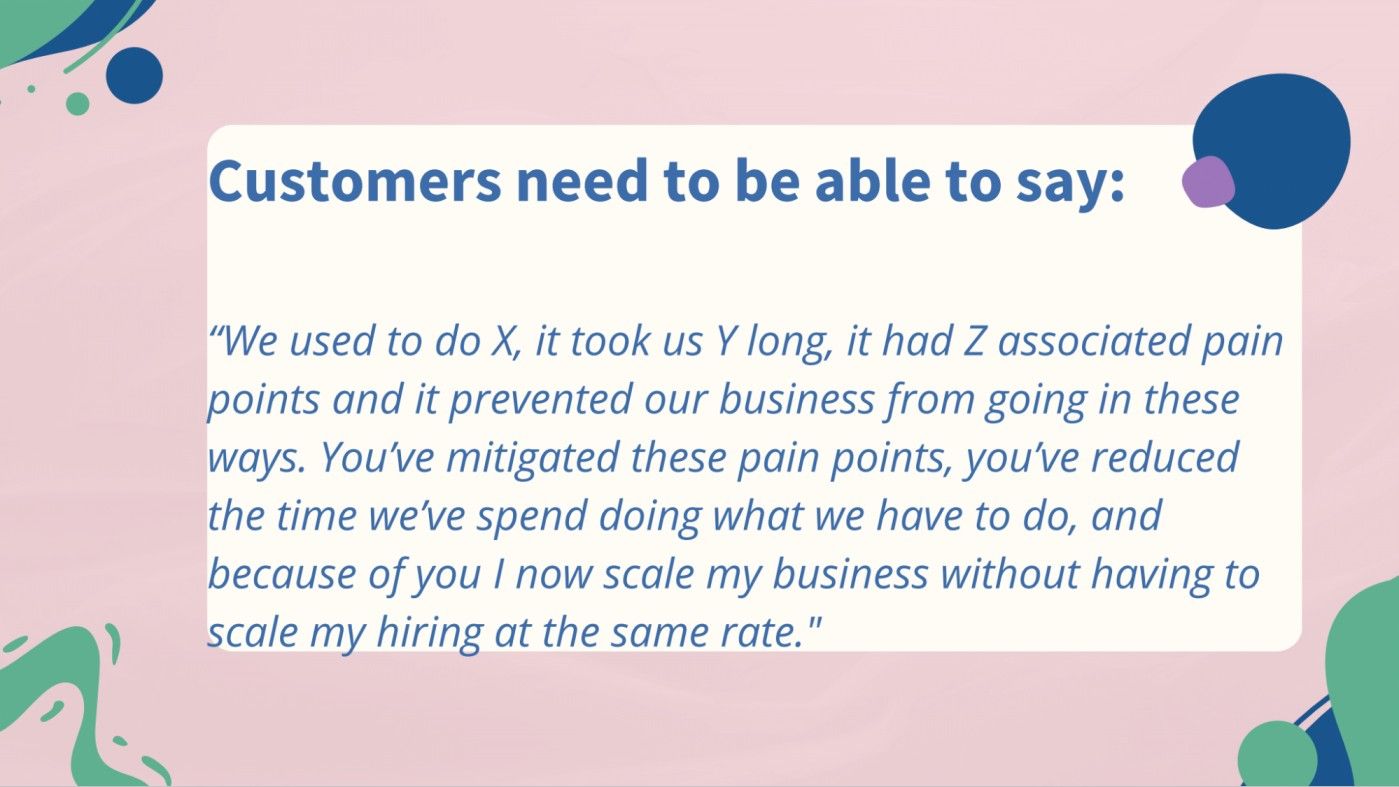
Our goal is to enable our customers to articulate a clear before-and-after scenario: "We used to do ‘X,’ which took ‘Y’ amount of time and had ‘Z’ associated pain points, hindering our business growth in these specific ways.
Your solution has not only mitigated these pain points and reduced the time we spend on necessary tasks, but it has also allowed us to scale our business without proportionally scaling our hiring."
Achieving this level of customer satisfaction and operational efficiency is not serendipitous - it's the result of meticulous analysis of data, active listening to customer feedback, and the continuous evolution of customer journeys.
To reach the point where our customer journeys preemptively address challenges and avoid potential roadblocks, we must position ourselves as the experts who anticipate and understand the customer's needs better than they do themselves.
We must constantly ask ourselves: “Where is our journey the strongest?” And more critically, “Where does it falter?”
By identifying these strengths and weaknesses, we can tailor the customer experience to not only meet but exceed expectations. It's about creating a seamless journey that feels personalized and proactive, one where the customer feels understood and well cared for at every touchpoint.
In the upcoming sections, I'll share how we can systematically collect and analyze customer feedback to inform and refine our customer journeys. This process is not just about fixing what's broken but also about reinforcing what works and making it even better.
The role of accountability in customer journey mapping
I want to emphasize a critical aspect of customer journey mapping: without an accountability partnership, it's merely a set of unattainable fantasies.
In the B2B SaaS space, a significant part of achieving expansion and retention goals hinges on being an accountability partner. Our customers may articulate their desires, but without visible data, adoption, or behavior change, we need to question and clarify those desires.
Are these truly the goals they aim to achieve? And if so, how do we hold them accountable to ensure they or their users utilize the software as needed?
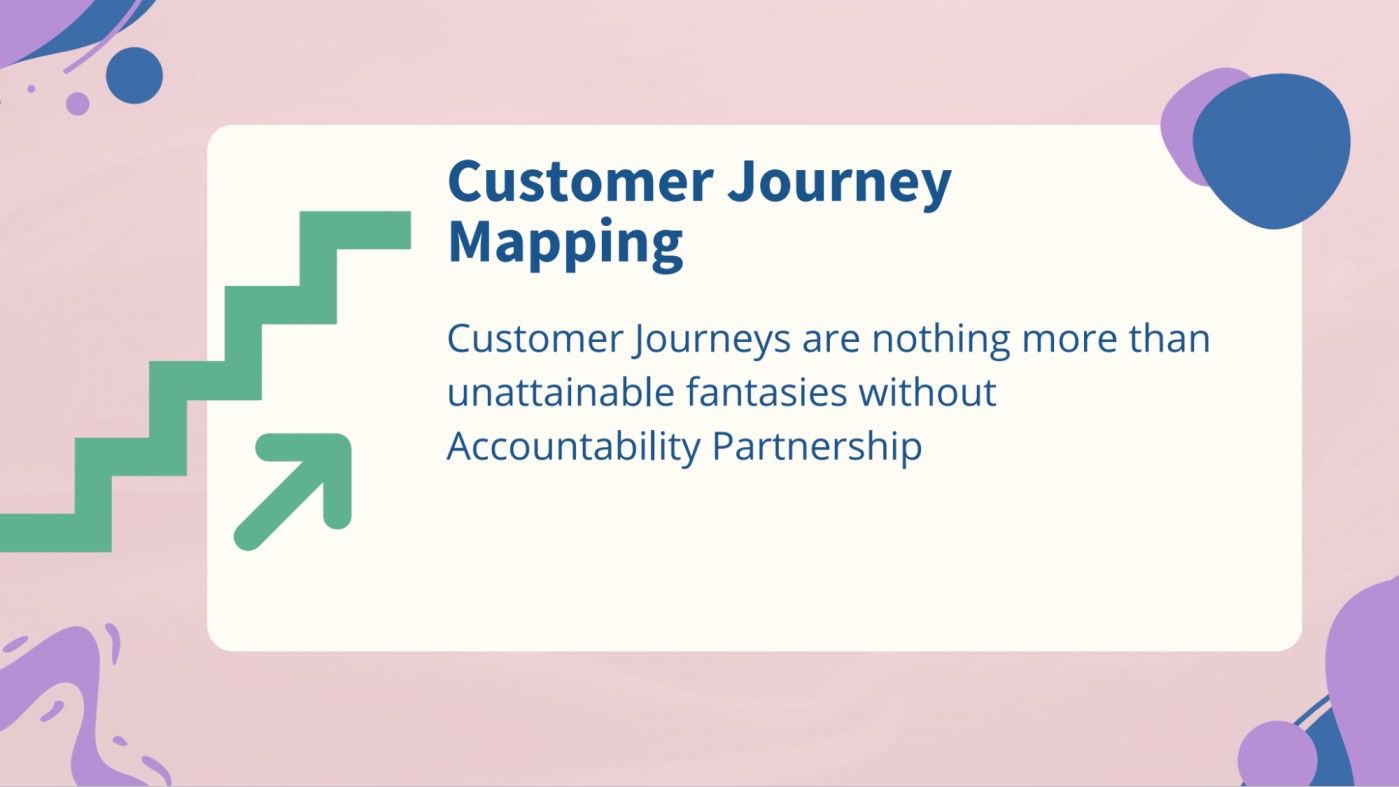
It's not uncommon to encounter a scenario where the individual who negotiated the sale has different priorities than the day-to-day contact managing the product. This discrepancy means we must adapt and expand our accountability plan to align with the motivations that drive our point of contact - be it bonuses, promotions, or other incentives.
Behavior change is challenging, but it's possible to collaborate with the customer to develop an accountability plan. This plan should be an ever-evolving customer journey with clear milestones and tentative dates leading to their goal.
It's also crucial to recognize that goals often need to be co-created with the customer. Most do not come to us with an objective and key result (OKR) or a specific metric tied to their purchase. Therefore, we must be proactive in suggesting goals based on our understanding of their industry, size, and other relevant factors.
For those who may be in the earlier stages of department maturity - perhaps stages one or two - without sufficient data to inform these suggestions, it's still possible to make an educated guess.
For instance, we might propose that by the end of the year, 80% of their teachers are recording and sharing at least one video per month. This goal could potentially reduce the time spent grading papers and maintain educational continuity when substitutes are needed, among other benefits.
Proposing a tangible, achievable goal like this is often greatly appreciated by customers. They value the guidance and the clarity it provides. It's a strategy I highly recommend, as it not only sets a clear direction for the customer's journey but also establishes a framework for accountability and success.
In the next sections, I'll discuss how to further refine these accountability plans and ensure they remain aligned with both the customer's evolving needs and our strategic objectives.
Applying the 3 Ts to customer success
In the world of B2B content marketing, the three Ts (teach, tailor, and take control) are well-known principles that are just as applicable to customer success.
Let's explore how these principles translate into actionable strategies for CS organizations.
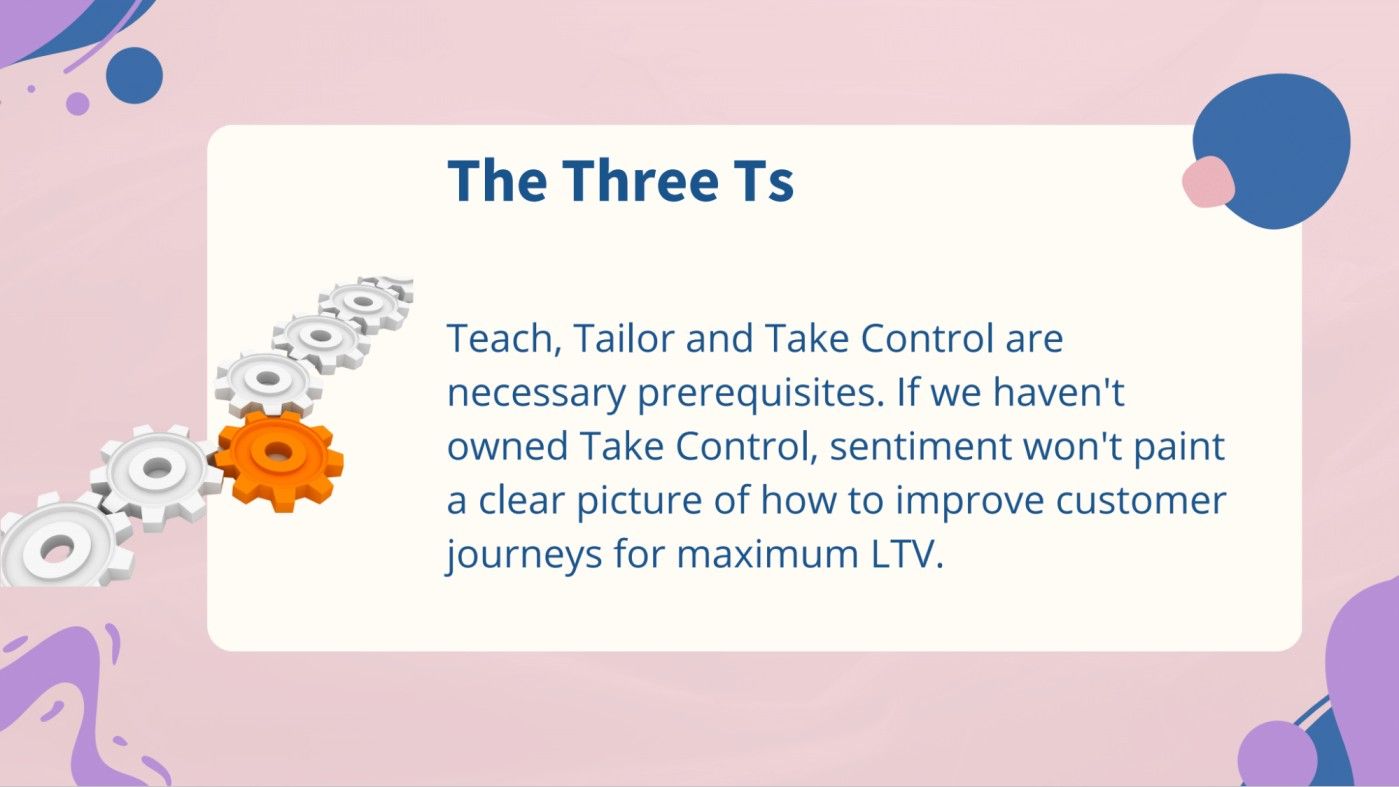
Teach
Most CS organizations excel at the first T, which is to teach. We're adept at educating customers on how our product can solve their challenges. This is foundational, as it sets the stage for customers to understand the value proposition of our offerings.
Tailor
Many CS teams also perform well with the second T, tailor. We know how to customize our solution to meet the specific needs of the customer. This personalization is crucial as it demonstrates our commitment to their unique situation and fosters a deeper connection with our product.
Take control
However, the third T, take control, is where many falter.
This step is about challenging customers to reassess their assumptions and processes - it's where we function as their accountability partner. Taking control means pushing for change, whether that's in their processes, goals, strategic approach, or any preconceived notions that may be hindering their success.
Every CSM on the team needs to be adept at taking control. This might involve pushing back on customer-defined success criteria if they're unrealistic or lack detail. It could mean scrutinizing inefficient workflows or addressing low engagement, which could lead to a lower likelihood of success.
Don't hesitate to use examples from other customers who have found success. Sharing best practices is an invaluable strategy. It provides a clear, evidence-based pathway for customers who may be hesitant or unsure about the proposed changes.
The most challenging aspect of taking control is the conversation itself. It involves asking tough questions and sometimes voicing concerns that may be uncomfortable. It's imperative to approach these conversations with respect and with the clear intention of helping the customer improve their business.
I like to equip CSMs with templates for these tough conversations. For instance:
- "You mentioned you wanted to improve X, but how will you quantify that, and in what timeframe?"
- "Your current workflow is X, then Z, then Y. However, we've seen that approach result in less value. What if we tried X, Y, and then Z instead?"
- "You signed up to achieve outcome X, but your team's login frequency has been low. Teams that don't engage regularly with our product from the start tend not to see the desired improvement. Can we work together to increase engagement, perhaps through some incentives?"
These examples are just the tip of the iceberg. The key is to be proactive, to guide the customer through the necessary changes, and to support them every step of the way.
Sentiment as a compass for customer journey optimization
With the foundational customer journeys established, sentiment becomes our compass, guiding us on when and how to adjust these journeys or introduce additional situation-based paths.
There are three primary channels through which we can gauge the highs and lows of the customer experience:
- Usage metrics
- Survey results
- CSM feedback
Let's delve into each of these.
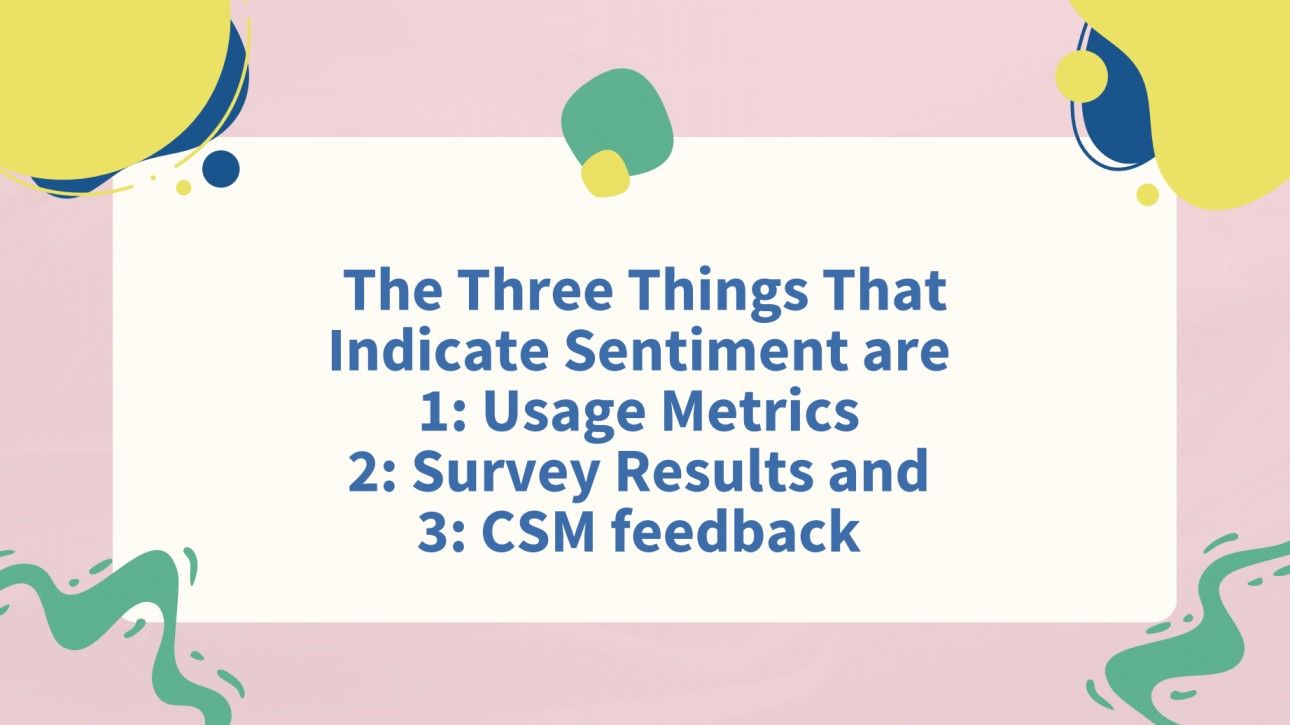
Usage metrics
When considering customer sentiment, usage metrics are a critical first category. They provide a clear picture of adoption patterns: Are customers using the product as we anticipated? Which features are they engaging with, and which are they neglecting?
This data is invaluable because it allows us to identify best practices among our most active users and replicate their success across our customer base.
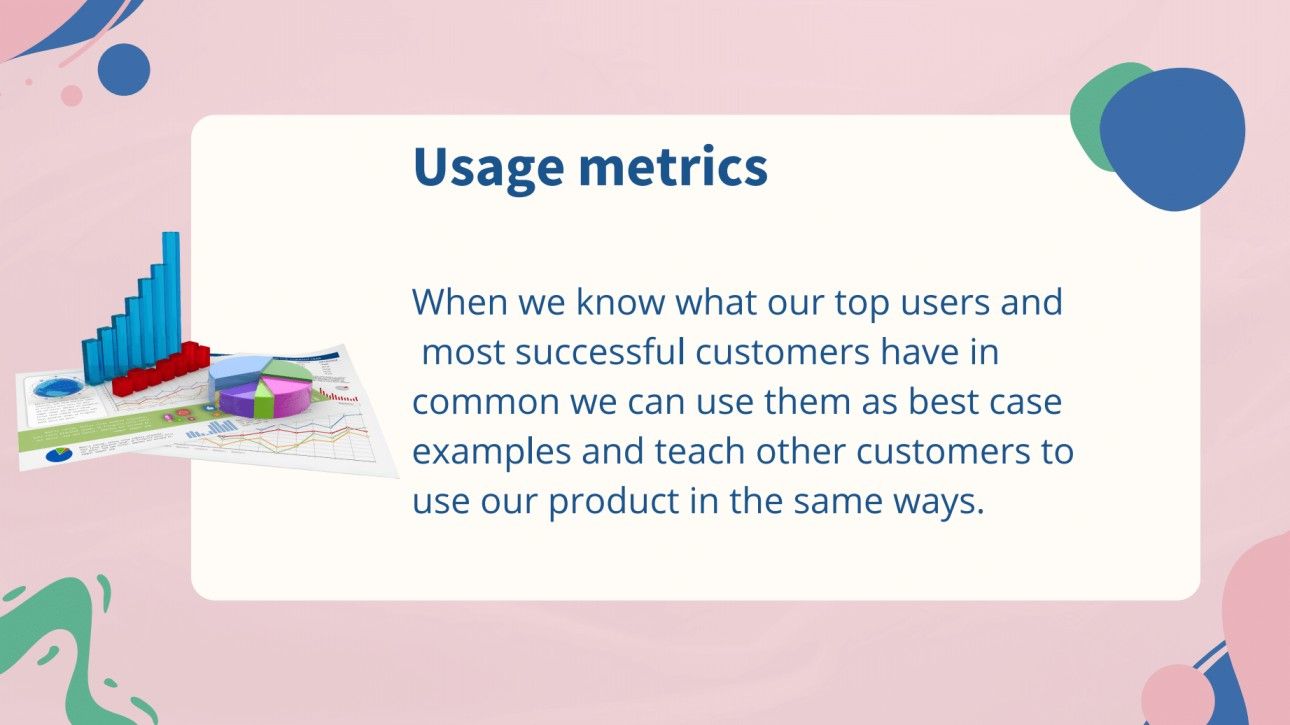
Take, for instance, my experience at an EdTech company serving schools and districts. Upon noticing that a particular school district had overall low usage but a subset of highly active users, we dug deeper.
We found that these power users were foreign language teachers who had innovatively used our product to streamline their teaching and grading processes. They recorded pronunciation prompts and had students submit their responses for feedback, a method that saved them countless hours traditionally spent grading papers.
With this insight, our action plan was twofold:
- Ensure access: We made it a priority to ensure every foreign language teacher had access to our tool.
- Spread best practices: We then extended this strategy to other customers, making sure foreign language teachers at different schools or districts were aware of and trained in this effective use of our product.
This approach allowed us to use usage data not just as a measure of sentiment but as a springboard for enhancing the customer journey.
We identified a successful user group and used their story to expand the journey to include other potential power users not yet engaged, and incorporate additional training and use case sharing, ensuring that all users understood the benefits and functionalities as demonstrated by the most active users.
Moreover, we took the success stories from one organization and used them to educate others. This involved modifying our training materials to highlight these power users and discussing with customers how they could replicate similar results.
By leveraging usage metrics in this way, we're not only improving the customer experience but also fostering a community of shared best practices. This not only enhances the value customers derive from our tool but also solidifies our role as a partner invested in their success.
Survey results
Surveys, particularly NPS (net promoter score) and CSAT (customer satisfaction) are tools I hold in high regard for their ability to capture customer sentiment. The perceived anonymity they offer is a game-changer; it often leads to more candid feedback than what a customer might share directly with their CSM.
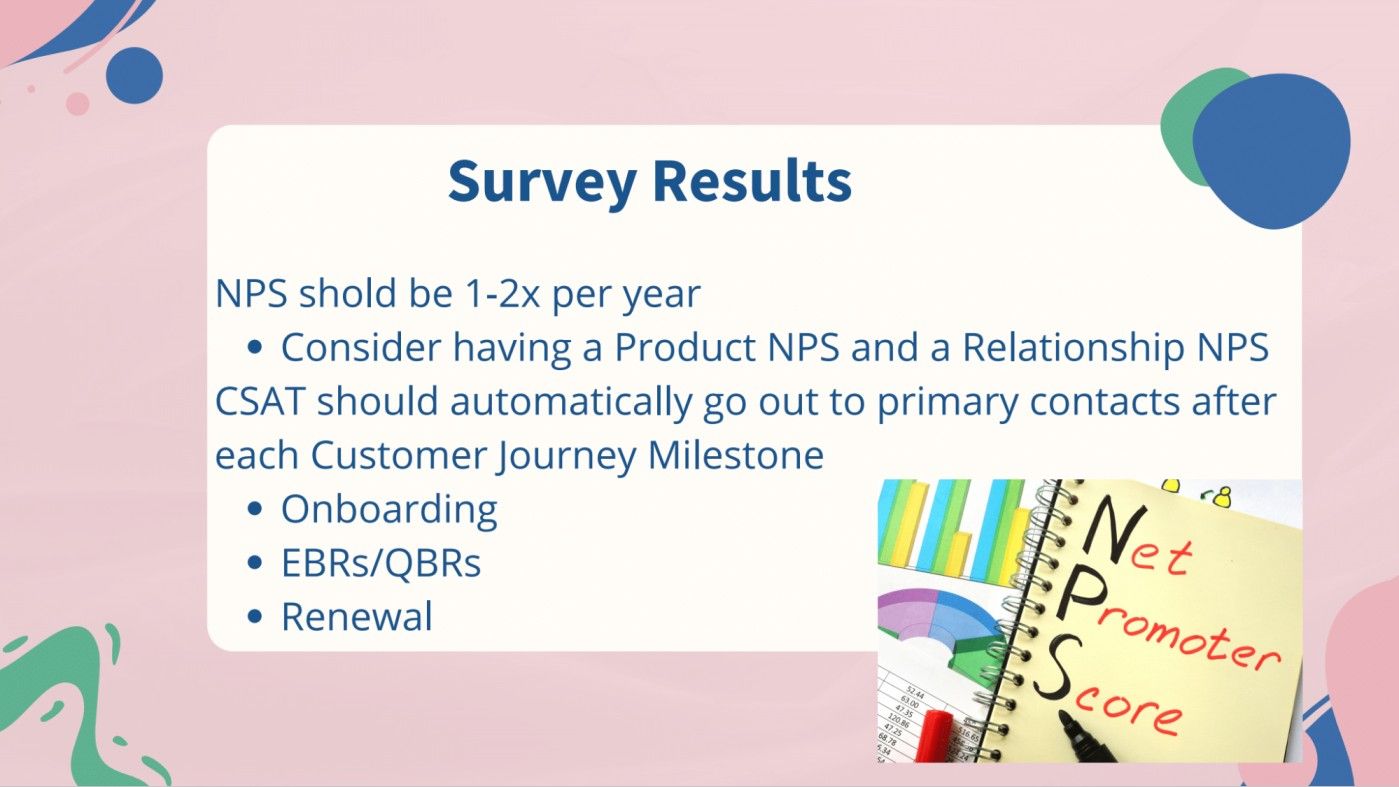
I've found it most effective to deploy two NPS surveys - one through a customer success tool and another through a product tool - to capture a full spectrum of feedback. This dual approach helps us understand both the product and relationship aspects of customer sentiment.
For example, a product pop-up survey reaches all users, while an email survey targets admins or license managers. By analyzing both, we can differentiate between a product NPS score and a relationship NPS score, each providing unique insights.
Responding to NPS feedback is critical. Promoters can be directed into automated journeys that encourage advocacy, such as participating in case studies or webinars. Passives, however, present a golden opportunity - they are the ones we should actively engage with to elevate their experience and potentially convert them into promoters.
Detractors, while important, should not consume the majority of our resources; instead, we should focus on those who are on the cusp of becoming brand advocates.
Utilizing customer success software to automate survey responses is essential. This allows us to:
- Send promoters communications from marketing about advocacy opportunities.
- Provide passives with direct access to executives for personalized discussions on improving their experience.
- Offer detractors additional surveys to pinpoint their concerns and assess churn risk.
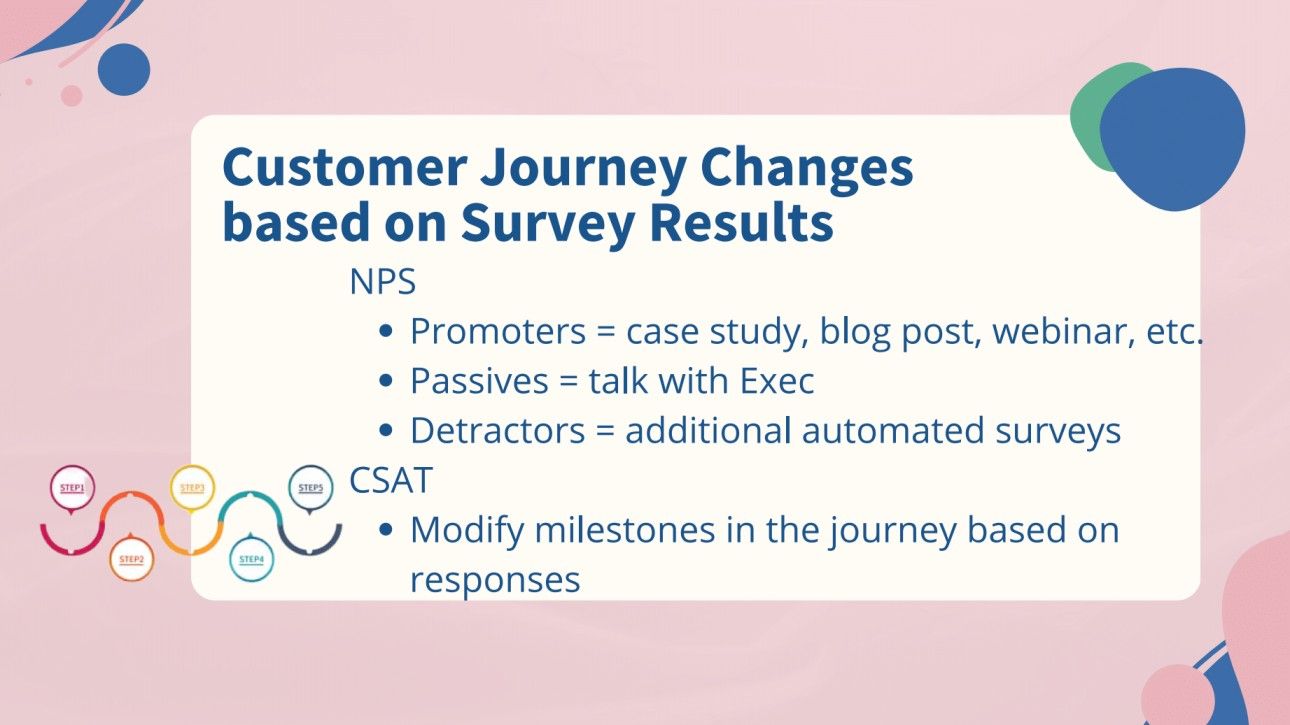
CSAT surveys should be dispatched at key milestones within the customer journey, such as post-onboarding or after significant meetings. These surveys help us identify where the customer journey shines and where it requires refinement.
To manage this process efficiently, it's imperative to reach at least stage three of customer success department maturity, where customer success software becomes instrumental.
Attempting to manually manage these surveys and the subsequent actions is not sustainable.
While NPS can be a lagging indicator and CSAT a more immediate one, it's the combination of these tools, along with the documentation and centralization of feedback, that enables us to act swiftly and effectively.
This holistic approach to sentiment analysis is what allows us to continuously refine our customer journeys and ensure we're meeting and exceeding customer expectations.
CSM feedback
The third and often underappreciated piece of sentiment analysis is the intuition of the CSM. While usage data and customer surveys are quantifiable and essential, the nuanced understanding a CSM develops through regular customer interactions is an incredibly reliable forecasting tool.

The human element that CSMs bring to the table is something I've learned to value deeply. Their “gut feeling” about a customer's likelihood to renew or churn is often spot-on. This is because CSMs are on the front lines, building relationships, and understanding the subtle cues that might not be immediately apparent in data alone.
In the early stages of a CS department, it's not uncommon to rely on spreadsheets for forecasting. I've been there - updating a spreadsheet with renewal likelihood percentages and notes. This manual process may work for startups at stages one or two of CS department maturity, but it's not a long-term solution.
To scale effectively, we need to integrate this sentiment tracking into CS software.
For instance, in ChurnZero this integration is as straightforward as a dropdown field where CSMs can rate the likelihood of account renewal after each interaction. This rating is then used to inform customer health scores and can even be integrated into CRM systems like Salesforce.
By incorporating the CSM's sentiment into the account's health score, we gain a more holistic view of the customer's status. This score is not just a number; it's a reflection of the customer's engagement, satisfaction, and the CSM's qualitative insights.
Recognizing that effective sentiment tracking and customer journey mapping require robust CS tools, it's crucial to secure the necessary budget to mature your CS department. I want to share some strategies on how to approach this, ensuring that you have the resources you need to build a scalable and impactful CS function.
Securing budget
In my journey as a VP of Customer Success, I've had to navigate the often-daunting task of securing a budget for our department. It's a common challenge, and one that requires a strategic approach to address effectively.
Chris Hicken, a customer success thought leader from 'nuffsaid, whose insights I greatly respect, has articulated a perspective on this topic that resonates with my own experiences.
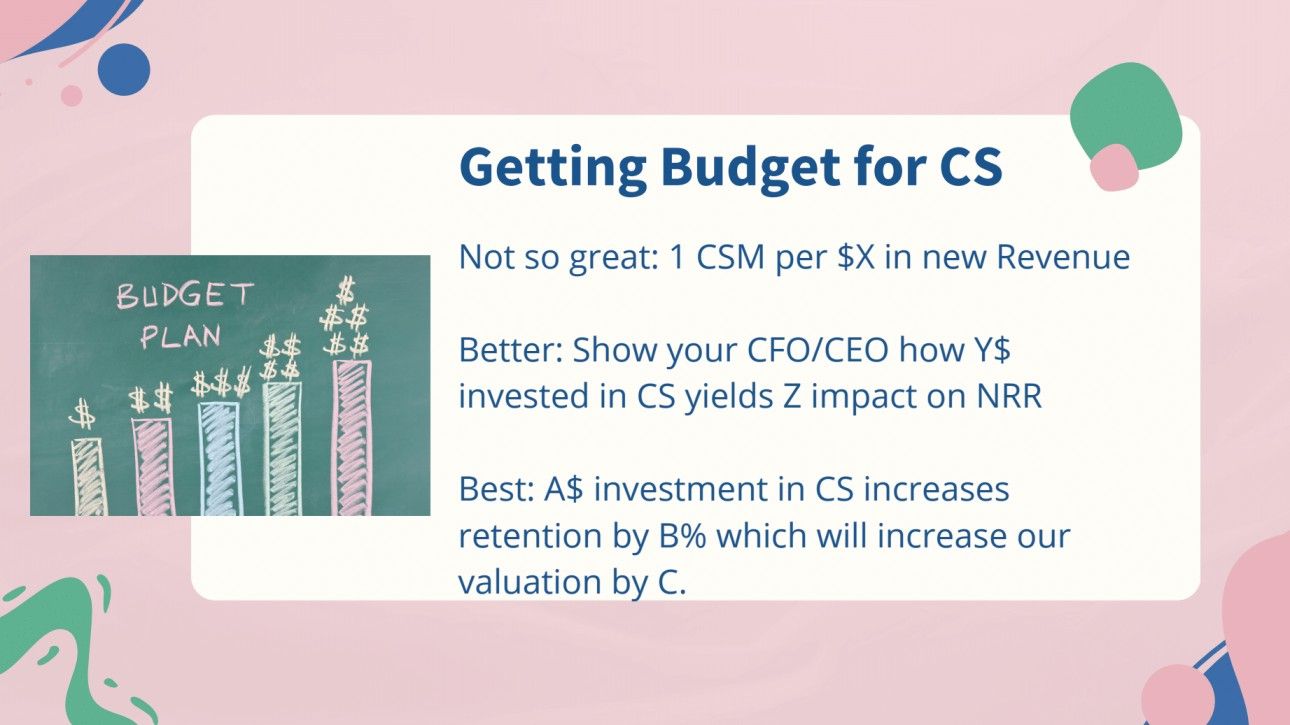
Chris suggests that the least effective way to request a budget is by using traditional metrics, such as the number of customers per CSM or revenue per CSM. While these are straightforward, they don't capture the true impact of customer success on the business.
A more compelling approach is to demonstrate how investments in customer success can positively influence net revenue retention (NRR). This is a step in the right direction as it ties the CS function directly to revenue, which is more likely to capture a CFO's attention.
However, the most mature and effective strategy is to align your request with what the CFO values most: maximizing the company's valuation. It's a hard truth, but at the end of the day, the CFO's primary concern isn't the customers themselves - it's the numbers that reflect the company's performance and, by extension, its valuation.
Retention rates are not just internal metrics; they are critical indicators used by Wall Street to gauge the health and potential of SaaS companies. By presenting a clear correlation between investment in customer success and an increase in company valuation through improved retention, you speak directly to the CFO's core concerns.
In startups, where historical data may be scarce, leveraging case studies or examples from similar companies can be incredibly persuasive. Illustrating how comparable investments in customer success have led to significant valuation increases provides a powerful narrative that can sway decision-makers.
In my role, I've learned that it's not just about asking for more resources - it's about making a compelling case for investment in customer success as a strategic move to increase the company's value. This approach has proven to be an effective way to secure the necessary budget to enhance our customer success initiatives and, ultimately, contribute to the company's growth and success.
Embracing accountability partnership in customer success
As we delve deeper into the nuances of customer success, it's crucial to revisit the concept of accountability partnership, a cornerstone of effective customer management and departmental leadership.
This isn't just a buzzword; it's a practice that I've woven into the fabric of our operations at Screencastify, and it's something I advocate for every customer success team to adopt.
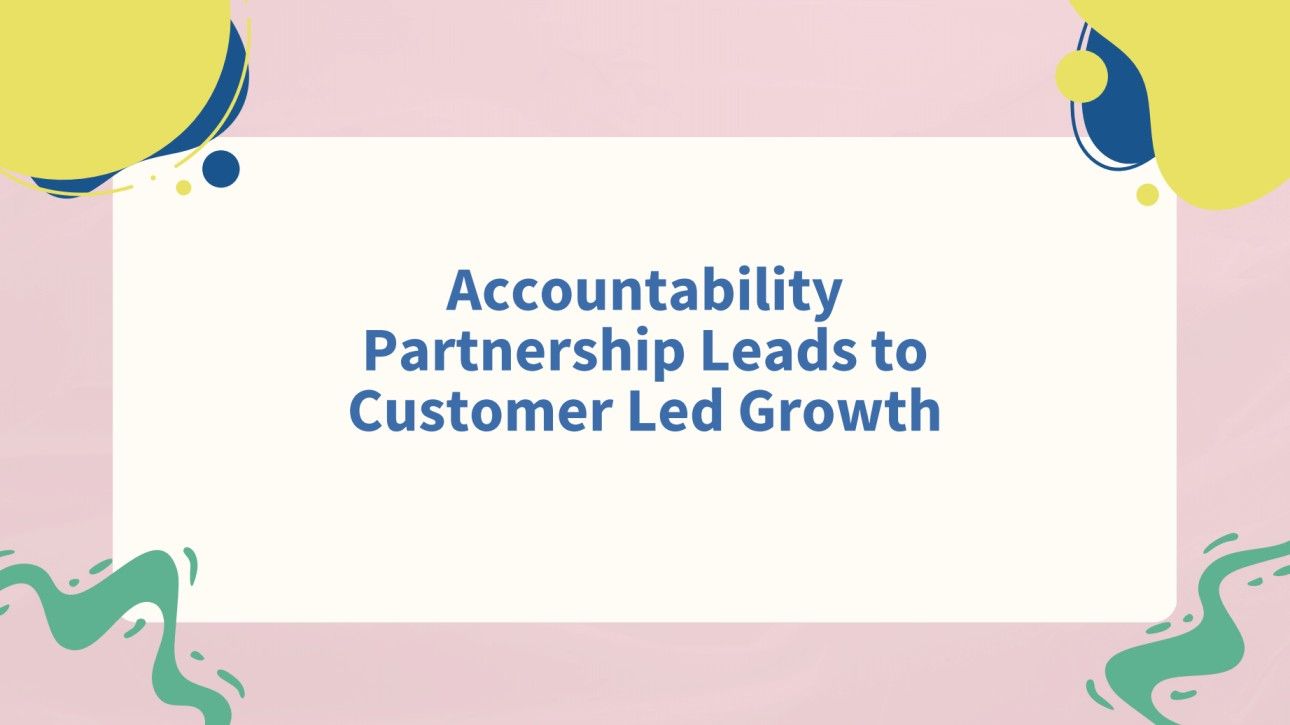
At the CSM level, accountability partnership is about more than just overseeing account health; it's about actively guiding customers toward their goals. It's about ensuring that every interaction and every piece of advice we give moves them one step closer to realizing the full potential of our product.
This means holding customers accountable to the action items we've agreed upon and being a steadfast partner in their journey toward success.
However, accountability doesn't stop with our CSMs. As leaders, we must also hold ourselves accountable to our customers and our teams.
This means ensuring that our department is equipped with the tools, training, and support needed to deliver exceptional customer experiences. It's about creating an environment where feedback is not just heard but acted upon, where customer insights shape the way we operate.
Customer-led growth
The concept of customer-led growth is gaining momentum in the customer success space and for a good reason. It's about taking the insights gleaned from customer interactions - what they tell us and what they show us through their behavior and usage - and using that data to refine our approach.
It's about recognizing patterns, identifying niche segments, and crafting customer journeys that are as unique as the customers themselves.
The maturation of a customer-led CS department is an ongoing process. It involves a shift from a one-size-fits-all approach to one that is dynamic and responsive.
By leveraging the data from CS software - usage metrics, survey results, and CSM feedback - we continuously refine and personalize the customer journey. This isn't a static process but a cycle of constant evolution, driven by the needs and experiences of our customers.
In my role, I am committed to fostering a culture of accountability and customer-centricity. It's about ensuring that every decision we make and every strategy we implement is done with the customer's best interests at heart.
By prioritizing customer experience and embracing the principles of customer-led growth, we not only enhance our department's maturity but also pave the way for sustainable, long-term success.
Value vs. impact in customer success
I want to emphasize a distinction that's often overlooked but is critical to our mission: the difference between value and impact. Understanding and communicating this difference is not just a matter of semantics; it's the foundation upon which long-term customer relationships are built.
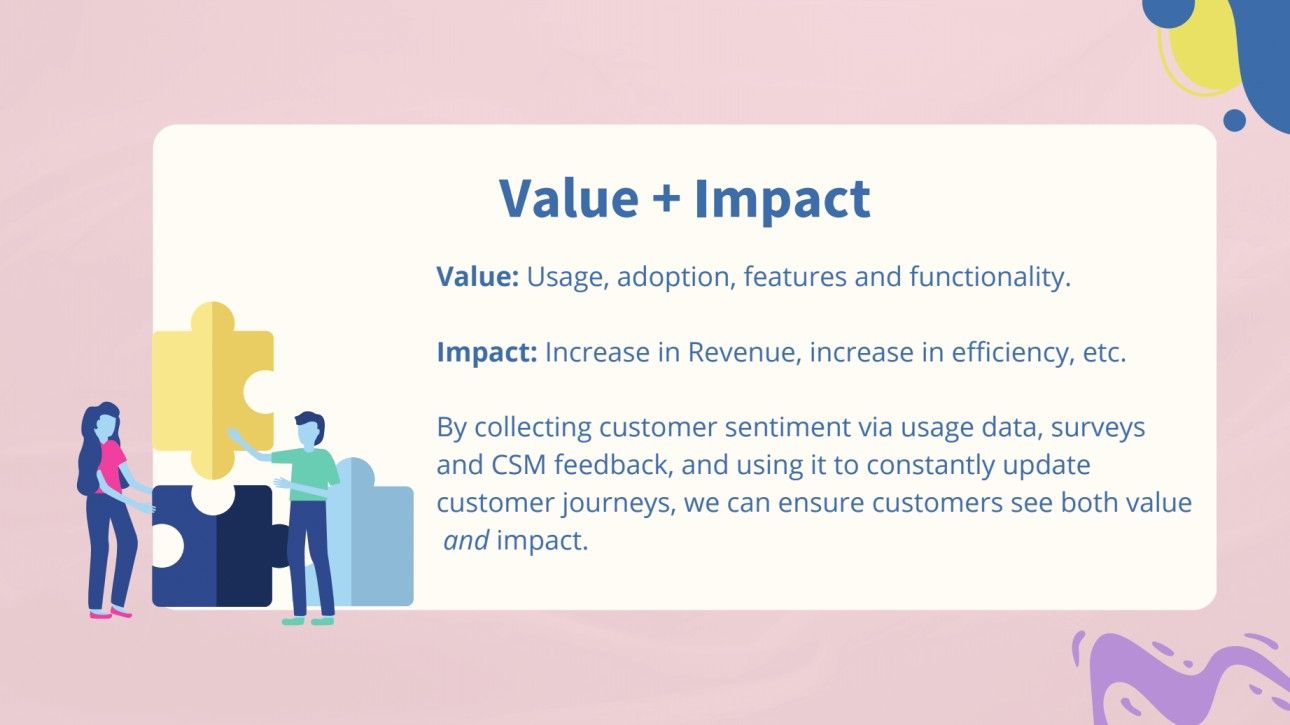
Value, in the context of customer success, is immediate. It's the tangible benefits that customers experience when they start using our product. It's about features, usability, and adoption. It's the quick wins that make a customer feel good about their purchase decision. But while value is what gets customers in the door, it's the impact that keeps them there.
Impact goes deeper. It's the strategic, long-term benefits that resonate on a higher level with our customers. It's about the profound changes that our product brings to their business operations, the efficiencies gained, and the new opportunities unlocked. Impact is the story of transformation and growth that our customers can tell because of what we've helped them achieve.
A perfect analogy is the Instapot. When you first use it, you're delighted by its functionality - that's value. But the true impact is realized when it changes your lifestyle, freeing up time and space, allowing you to focus on what matters most. That's the kind of transformation we aim for with our products.
Our goal in customer success is not just to ensure that customers are using our product but to help them achieve a significant, positive impact on their business. It's about guiding them from realizing immediate value to experiencing transformative impact. And this journey is not something we keep to ourselves; it must be articulated clearly so that our customers can express it in their own words.
As we collect and analyze data on customer sentiment, as we refine our use cases and journeys, we're doing more than just improving a service - we're deepening our relationships.
We're committing to not only show our customers the path to value but to walk with them towards a lasting impact. Because at the end of the day, the reason customers will continue to invest in our product, to deepen their engagement with us, is the measurable, meaningful impact we've had on their success.
Our work in customer success is a blend of art and science. It's about understanding the nuances between value and impact and being able to lead our customers from one to the other. It's about being partners in their journey, not just providers of a service. And that's a commitment I take to heart every single day.
How about designing a customer success function of your own?
It's time to learn how.
Has this article opened your eyes to the possibility of designing your own customer success strategy, we have the perfect course to help you position CS as the revenue driver it is to your leadership team.
Introducing... Building a Customer Success Team Certified: Masters.
By taking this course, you'll discover how to:
🔧 Leverage technology and automation to streamline customer success operations and improve efficiency.
🧑🎨 Sculpt out a strong CS function and learn for your business, including where CS slots into the client experience and why it’s an investment for the future.
🎨 Create effective customer onboarding processes and ensure a seamless transition from sales to customer success that sets the stage for long-term relationships.
🧱 Build a culture of continuous improvement by cultivating a mindset of learning and growth within your customer success team.



 Follow us on LinkedIn
Follow us on LinkedIn







